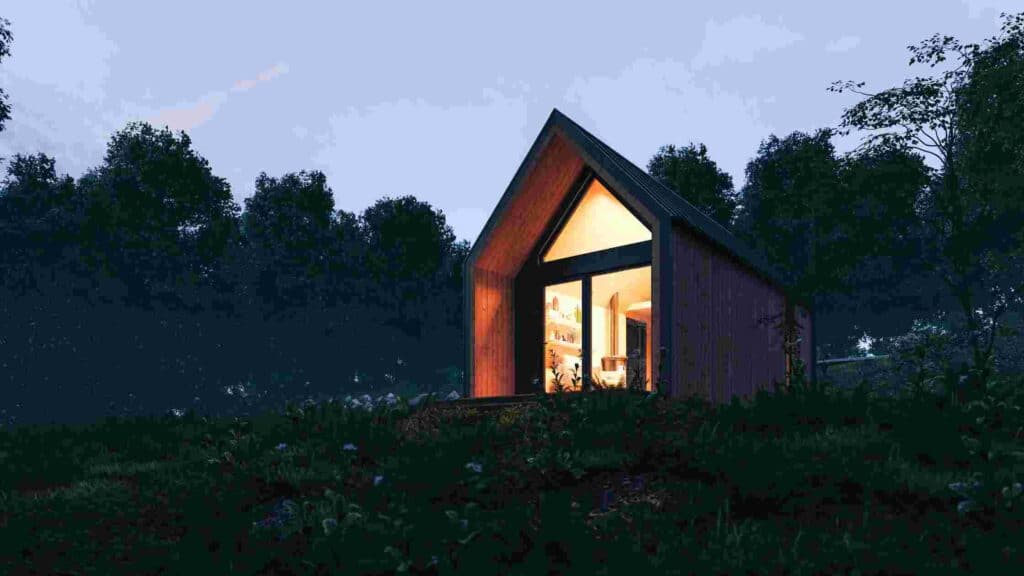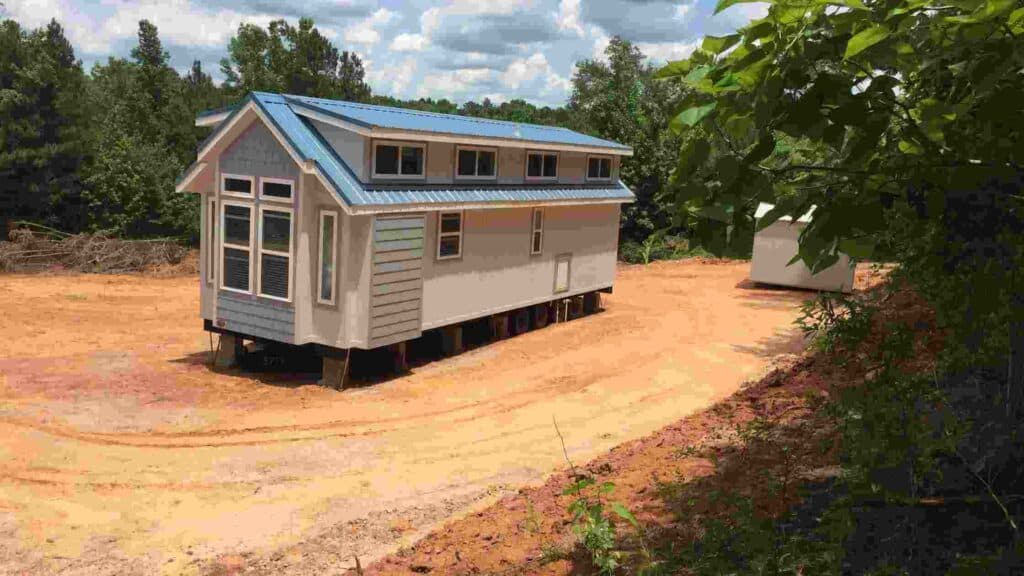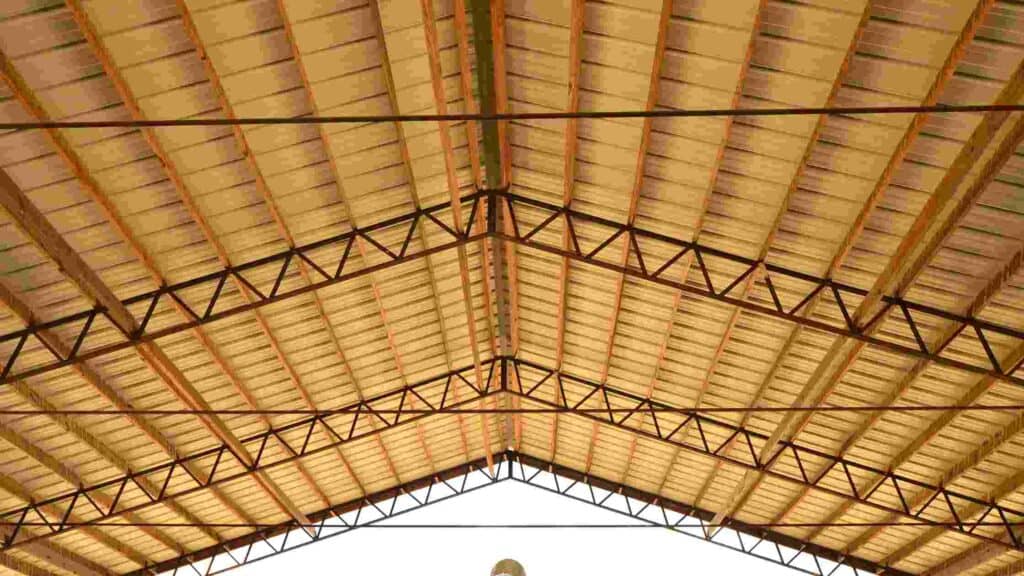Tiny houses are becoming popular, offering practicality and beauty in a compact package. But can you put a tiny house in your backyard?
In most cases, it’s a green light, but there are some rules and regulations to navigate. Join us as we delve into the details of having a tiny house in your backyard.
Codes And Regulations: Can You Put A Tiny House In Your Backyard?
Before you start sketching out your dream tiny home, it’s crucial to understand that codes and regulations can vary significantly depending on where you live.
The permissibility of having a tiny house in your backyard often hinges on the specific type you plan to build.
However, it’s essential to note that you’re more likely to encounter resistance if your tiny home is the sole structure on your property.
Even if it’s tucked away in your backyard, it’s a courteous gesture to consult your neighbors and ensure they’re comfortable with the idea.
Building On A Solid Foundation

Opting for a tiny house built on a foundation essentially means constructing a scaled-down version of a conventional house.
Typically, the foundation is crafted from concrete and follows standard framing techniques, resulting in a structure that’s just as robust as a traditional home.
Designating Your Tiny House As A Secondary Home
If your plan is to use the tiny house in your backyard as a secondary residence, the rules and regulations might tilt more in your favor. This distinction is essential, as it can significantly influence the red tape you’ll encounter.
Since you’re adding a tiny home to a property you already own, you’ll likely face less resistance from local authorities.
Additionally, having a tiny house in your backyard can boost your property’s overall value, a detail that often pleases your neighbors (you might also be interested in checking out how to make an ugly yard pretty).
The Pros Of A Foundation-Based Tiny House
Here are some advantages to consider when building your tiny home on a foundation:
- Durability: These homes are robust and built to last.
- Cost: Foundation-based tiny houses tend to be more budget-friendly.
- Availability of Materials: Sourcing materials is convenient.
- Easier to Build: Standard framing techniques simplify construction.
Constructing a tiny home on a foundation is relatively straightforward. Since it follows standard framing techniques, the plumbing and electrical systems align with those of a typical house.
You can choose to go on-grid or off-grid, but the latter is often easier to set up. With a fixed location, concerns about the added weight of batteries or water tanks are minimized.
Moreover, your tiny house on a foundation won’t have to endure the wear and tear of constant travel. This longevity, coupled with the ease of finding replacement parts, can make foundation-based tiny homes a much more affordable choice.
So, if budget considerations are paramount, this could be the way to go, provided local laws permit.
Cons Of Having A Tiny House On A Foundation
While there are numerous perks to building a tiny house on a foundation, it’s important to consider the potential downsides:
1. Less Individualized Options
With the constraints of zoning regulations and local building codes, you might find yourself with fewer customization and design options for your tiny house on a foundation.
These rules can impose limitations on the exterior appearance, layout, and size of your dwelling.
2. Limited Mobility
The most glaring drawback of a foundation-based tiny house is its immobility.
Once it’s in place, it’s there to stay. Unlike tiny houses on wheels, which can be moved with relative ease, a foundation-based tiny home is firmly rooted in one location.
Depending on where you live, you could find yourself wrestling with local building codes. These codes might dictate various aspects of your tiny house, from its structural requirements to its size.
Some towns even set minimum size requirements, which could hinder your plans for a compact dwelling.
Tiny Houses On Wheels: Tiny Houses Without Foundations

If the notion of a fixed, foundation-based tiny house doesn’t quite align with your vision, fear not. There are alternative paths to tiny living that offer more flexibility.
Tiny houses on wheels, often referred to as “THOWs,” are constructed atop trailers, offering a mobile housing solution. These tiny abodes come in a range of sizes, from cozy 10-foot models to spacious 40-foot dwellings.
Pros Of Tiny Houses On Wheels
1. Legal Flexibility
Because tiny houses on wheels are considered trailers, they often sidestep the labyrinth of local building codes that can complicate the placement and construction of foundation-based tiny homes. This legal flexibility can make your tiny house journey much smoother.
2. Mobility
The primary advantage of a tiny house on wheels is right there in the name—mobility.
Since these homes are classified as trailers rather than traditional houses, they can be moved from one location to another with relative ease. This mobility is a game-changer, especially if local regulations prohibit foundation-based tiny homes.
3. Resale Value
Surprisingly, tiny houses on wheels tend to hold their resale value well.
If you ever decide to part with your tiny home, you can often recoup a significant portion of your investment. Some individuals even profit from selling their tiny houses after enjoying them for a period.
4. Personalization
Tiny houses on wheels offer a canvas for individuality.
You have the freedom to personalize your mobile home according to your preferences, subject to road-worthy safety standards. This flexibility allows for creative designs and layouts that suit your lifestyle.
Cons Of Tiny Houses On Wheels
While the idea of having a home on wheels is undeniably enticing, it’s crucial to acknowledge the potential downsides of opting for a tiny house on wheels:
1. Maintenance Requirements
Maintenance is a significant concern for tiny houses on wheels. Regular upkeep is essential to counteract the inevitable effects of travel.
Tire maintenance, rust prevention, and addressing road-induced wear become recurring tasks that homeowners must manage diligently.
2. Towing Challenges
Unlike a traditional foundation-based tiny home, a tiny house on wheels doesn’t possess the same reliable, rock-solid base.
The trailer it rests upon is susceptible to rust, and over time, the tires may dry rot. If your tiny house frequently hits the road with you, it’s exposed to wear and tear from varying road conditions and wind.
3. Complex Construction
Building a tiny house on wheels is a more intricate process compared to a stationary home. It must withstand conditions that stationary homes don’t typically face, such as the vibrations and stresses of travel.
Additionally, the electrical and plumbing systems require a setup similar to a mobile home rather than a conventional house.
4. Cost Considerations
Surprisingly, the cost of owning and maintaining a tiny house on wheels can add up.
From the initial investment in the construction and trailer to ongoing maintenance, this option might not be as budget-friendly as it first appears.
5. Towing Your Tiny House
Transporting your tiny house on wheels comes with its own set of considerations.
You must account for the weight of the home and ensure that the vehicle used for towing has a sufficient tow rating. This involves careful planning and potentially upgrading your towing vehicle.
Pole Barns As An Alternative

For those seeking an alternative to both foundation-based and wheeled tiny houses, pole barns offer a unique solution.
These structures are framed on posts set into the ground and don’t fall under the same building codes as other tiny houses.
Pros Of Pole Barns
1. Simplicity In Construction
Building a pole barn is relatively straightforward. The construction process is simpler compared to the intricacies of building a tiny house on wheels, making it accessible to a wider range of DIY enthusiasts.
2. Cost-Effective Construction
Pole barns tend to be more cost-effective to build than both traditional foundation-based homes and tiny houses on wheels. This budget-friendly option can be attractive to those on a tight budget.
Cons Of Pole Barns
1. Lack Of Mobility
Similar to foundation-based tiny homes, pole barns are immobile structures. If mobility is a priority for your tiny living experience, pole barns may not be the ideal choice.
2. Reduced Durability
Pole barns, like tiny houses on wheels, lack the durability of foundation-based homes. Their construction style makes them susceptible to wear and tear over time.
FAQs – Putting A Tiny House In Your Backyard
1. How do you hook up a tiny house in your backyard?
To hook up a tiny house in your backyard, you’ll need utility connections for water, sewage, and electricity, similar to an RV hookup.
2. Do I need a permit to build a tiny house on my property?
Permit requirements for building a tiny house on your property vary by location. Check with your local zoning or building department.
3. Where can you legally put a tiny house?
The legal placement of a tiny house depends on local zoning laws. Options may include your backyard, RV parks, or designated tiny house communities.
4. Is it possible to have multiple tiny homes on one property?
Some areas allow multiple tiny homes on one property, but regulations differ. Consult local zoning ordinances for specifics.
5. Can a family live in a tiny house?
Yes, a family can live in a tiny house, but it requires careful planning and maximizing space efficiency to accommodate everyone comfortably.
Conclusion: Can You Build A Tiny House In Your Backyard?
The ability to place a tiny house in your backyard largely depends on your location and local regulations.
It’s crucial to thoroughly research and understand the rules and restrictions governing tiny houses in your area before embarking on your tiny home journey.
Each variety of tiny houses, whether on a foundation, wheels, or in a pole barn, comes with its own set of benefits and drawbacks. Ultimately, your choice should align with your preferences, lifestyle, and budget.
You might also find the following article helpful: Can I put a shipping container on my property?
